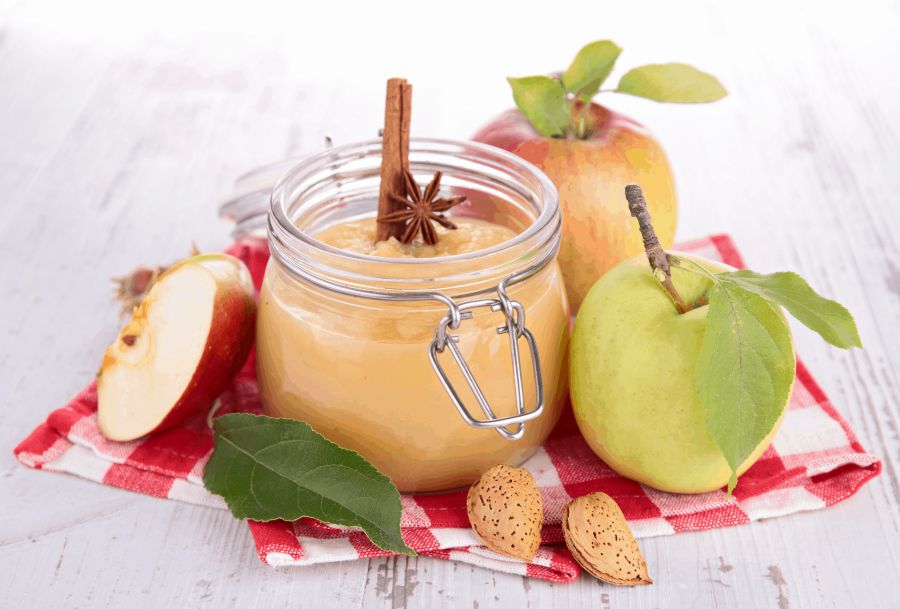Well, you may be wondering if it’s safe to try feeding your dog applesauce. This fantastic kids’ delicacy is not only safe for your dog but also very nutritious. As a pet parent, trying new foods for your dog can be hesitant.

Most kids grow up with applesauce as their staple food, and it’s also a good snack for adults. The food is full of fiber, minerals, and vitamins, making it nutritious even for your dog.
What Are the Benefits of Applesauce to Your Dog?
Well, an apple a day can keep the doctor away, right? So, here are some benefits of applesauce that might make you think about it.
#1. Nutrients
Applesauce contains the same nutritional benefits as fresh apples. Applesauce comes in different flavors and varieties.
Some contain extra flavors, color, and other fruits. Other applesauce contains only water and ascorbic acid.
#2. It Is Safe!
Applesauce contains low fats, sodium, and calories, so it is safe for your dog.
#3. Weight Loss
Applesauce can generally help to improve heart function and promote weight loss. The presence of antioxidants in the applesauce protects the dog from free radicals.
#4. Digestion
Applesauce is high in fiber which is good for your dog’s digestion. The presence of calcium and phosphorus strengthens your dog’s bones, nails, and teeth.
#5. Source of Vitamins
Vitamin C in applesauce is great with degenerative conditions such as joint diseases. Likewise, Vitamin A will promote a healthy coat and skin for your precious dog. Applesauce can help keep cholesterol low and also reduce the risk of diabetes.
In the end, applesauce is as significant to your dog as it is to you.
How to Tell if Your Dog Likes Applesauce?
If you have been a pet parent, it will be easy to know whether your dog likes or dislikes something. Being a new pet parent can be a little tricky but also easy to learn. Trying applesauce on your dog for the first time will have three expected results.
The way the dog will react to the food after serving the applesauce is enough communication. Your dog may look at the bowl served, sniff it and sit back and look at your disappointment. The dog may also walk away without bothering to check out the bowl again. It is clear that the dog did not like the applesauce and won’t try even a bite.
Another reaction may be the dog taking a bite or few bites and then stops. Depending on how your dog usually communicates their disappointment, you will know it.
The final and exciting reaction is your dog enjoying the food and gulping on it so fast. The dog may jump around to show satisfaction or stare at you wagging its tail, waiting for more.
Other reactions from your dog to show they like the food include bark and licking their lips. The dog may also cry for more or stare at the food, with the hope that you’ll add more. A wagging tail plus a cry means the dog is craving for more.
How Much Applesauce Should You Feed Your Dog?
If your dog falls in love with applesauce, you may want to feed him a lot of it. Feeding your dog with as much applesauce as they wish to consume is a bad idea. It may cause more harm than the good you hope for the dog.
Like said earlier, applesauce is more like fruit juice. It is rich in fiber that should be a treat and not a regular meal. The fibrous fruit sauce can cause digestive issues for your dog if consumed in large quantities. It is essential to regulate how much the dog consumes, even if it turns out to be the dog’s favorite.
Consider applesauce as a special treat for your dog. A treat is never given every day but occasionally. 5% of applesauce on your dog’s diet is enough to get ample benefits. Treat applesauce the same way you would treat sliced apples in the dog’s diet.
Final Thoughts!
Applesauce may not be so good for your newborn puppy so avoid it as their digestive system is still developing.
Grown-up dogs digest fruits and vegetables better in small quantities. So avoid feeding your dog with too much applesauce. In short, organic and sugar-free applesauce brands are better to feed your dog with as they are less toxic.
